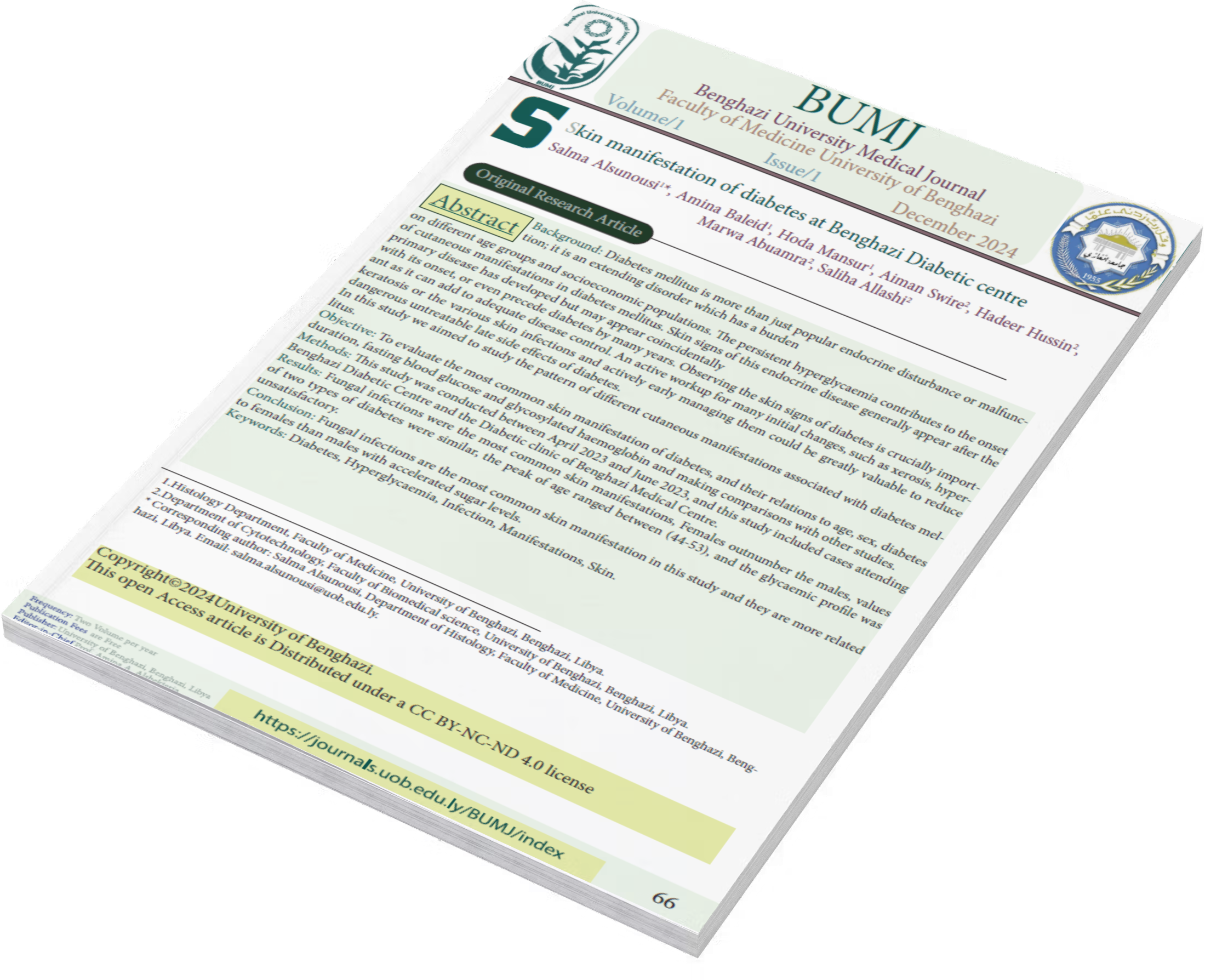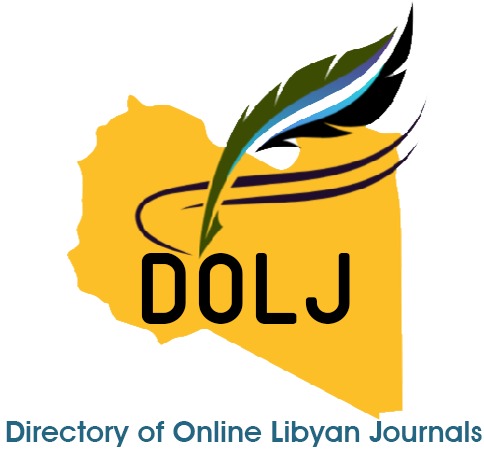Skin manifestation of diabetes at Benghazi Diabetic centre
DOI:
https://doi.org/10.37376/benunivmedj.v1i1.7142Keywords:
Diabetes, Hyperglycaemia, Infection, Manifestations, SkinAbstract
Background: Diabetes mellitus is more than just popular endocrine disturbance or malfunction; it is an extending disorder which has a burden on different age groups and socioeconomic populations. The persistent hyperglycaemia contributes to the onset of cutaneous manifestations in diabetes mellitus. Skin signs of this endocrine disease generally appear after the primary disease has developed but may appear coincidentally
with its onset, or even precede diabetes by many years. Observing the skin signs of diabetes is crucially important as it can add to adequate disease control. An active workup for many initial changes, such as xerosis, hyperkeratosis or the various skin infections and actively early managing them could be greatly valuable to reduce dangerous untreatable late side effects of diabetes.
In this study we aimed to study the pattern of different cutaneous manifestations associated with diabetes mellitus.
Objective: To evaluate the most common skin manifestation of diabetes, and their relations to age, sex, diabetes duration, fasting blood glucose and glycosylated haemoglobin and making comparisons with other studies.
Methods: This study was conducted between April 2023 and June 2023, and this study included cases attending Benghazi Diabetic Centre and the Diabetic clinic of Benghazi Medical Centre.
Results: Fungal infections were the most common skin manifestations, Females outnumber the males, values of two types of diabetes were similar, the peak of age ranged between (44-53), and the glycaemic profile was unsatisfactory.
Conclusion: Fungal infections are the most common skin manifestation in this study and they are more related to females than males with accelerated sugar levels.
References
. Olokoba AB, Obateru OA, Olokoba LB. Type 2 diabetes mellitus: a review of current trends. Oman Med J. 2012 ;27(4):269-73. doi: 10.5001/omj.2012.68. PMID: 23071876; PMCID: PMC3464757.
. De Macedo GMC, Nunes S, Bareto T. Diabetol Metab Syndr (2016) 8:63 DOI 10.1186/s13098-016-0176-y
. Moraes, V.R.; Melo, M.O.;Maia Campos, P.M.B.G. Evaluation of Morphological and Structural Skin Alterations on Diabetic Subjects by Biophysical and Imaging Techniques. Life 2023, 13, 579. https://doi.org/10.3390/life13020579
. Man, M.Q.; Wakefield, J.S.; Mauro, T.M.; Elias, P.M. Alterations in epidermal function in type 2 diabetes: Implications for the
management of this disease. J. Diabetes 2022, 14, 586–595.
. Niaz F, Bashir F, Shams N, Shaikh Z, Ahmed I. Cutaneous manifestations of diabetes mellitus type 2: prevalence and association with glycemic control. J Pak Assoc Dermatol [Internet]. 2016;26(1):4-11. [cited 2023 May30] Available from: http://jpad.com.pk/index.php/jpad/article/view/67
. Al-Mutairi N, Zaki A, Sharma AK, Al-Sheltawi M. Cutaneous manifestations of diabetes mellitus. Study from Farwaniya hospital, Kuwait. Med Princ Pract. 2006;15(6):427-30. doi: 10.1159/000095488. PMID: 17047349.
. Phulari YJ, Kaushik V. Study of cutaneous manifestations of type 2 diabetes mellitus. Int J Res Dermatol 2018; 4:8-13.
. Dourmishev L, Pozharashka J. Dermatoses Associated with Diabetes Mellitus. J Skin Stem Cell. 2019;6(4): e101180. https://doi.org/10.5812/jssc.101180.
. Roslind S, Muhammed K, Sajeeth KG. Cutaneous manifestations in patients with type 2 diabetes mellitus and normal controls. J Skin Sex Transm Dis 2020;2(1):26-30. doi:10.25259/JSSTD_47_2019.

Downloads
Published
How to Cite
Issue
Section
License
Copyright (c) 2024 Benghazi University Medical Journal

This work is licensed under a Creative Commons Attribution-NonCommercial-NoDerivatives 4.0 International License.
Copyright©2024University of Benghazi.
This open Access article is Distributed under a CC BY-NC-ND 4.0 license








 Copyright
Copyright


